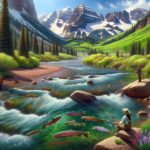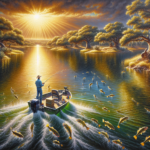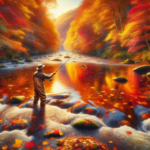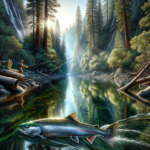Winter Ice Fishing in Minnesota’s Lakes
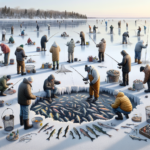
Introduction
Did you know that Minnesota boasts over 10,000 lakes, many of which transform into prime ice fishing spots during the winter months? Winter ice fishing in Minnesota’s lakes is not just a pastime; it’s a cultural phenomenon that draws thousands of anglers from across the country. This article will delve into the rich history, techniques, species, and best practices for ice fishing in Minnesota, providing you with all the information you need to make the most of this unique experience.
Whether you’re a seasoned angler looking to master new techniques or a novice eager to try your hand at ice fishing, this guide will cover everything from the best fishing spots and gear recommendations to safety tips and conservation practices. Understanding the nuances of winter ice fishing in Minnesota can significantly enhance your fishing experience and ensure you’re well-prepared for the challenges and rewards it offers.
Background/Context
Historical or Cultural Significance
Ice fishing has deep roots in Minnesota’s history and culture. Native American tribes, such as the Ojibwe, were among the first to practice ice fishing, using rudimentary tools to catch fish through holes in the ice. Over the centuries, this practice evolved, becoming a popular winter activity among settlers and modern-day Minnesotans. Today, ice fishing is not just a hobby but a social event, with communities often gathering on frozen lakes to share stories, food, and the thrill of the catch.
Geographical Overview
Minnesota, often referred to as the “Land of 10,000 Lakes,” offers a diverse range of water bodies ideal for ice fishing. The state’s climate, characterized by cold winters with temperatures often dipping below freezing, creates perfect conditions for ice fishing. The topography includes a mix of shallow and deep lakes, each supporting a unique ecosystem. Popular lakes for ice fishing include Lake Mille Lacs, Leech Lake, and Lake of the Woods, each offering different species and fishing experiences.
Key Points/Details
Fishing Techniques
Technique Overview
Ice fishing techniques can vary, but some of the most common include jigging, tip-ups, and dead sticking. Jigging involves using a small rod to move the bait up and down, mimicking the movement of prey. Tip-ups are devices that hold the fishing line and signal when a fish bites, allowing anglers to cover multiple holes. Dead sticking involves leaving the bait stationary, relying on the fish to come to it.
When and Where to Use
Jigging is particularly effective in deeper waters where fish are more likely to be active. Tip-ups are ideal for covering larger areas, making them useful in expansive lakes like Lake Mille Lacs. Dead sticking works well in shallower waters or when fish are less active, such as during colder periods.
Recommended Gear
- Rods: Light to medium action rods for jigging and dead sticking.
- Reels: Spinning reels with smooth drag systems.
- Lines: Monofilament or fluorocarbon lines, typically 4-8 lb test.
- Bait/Lures: Live bait like minnows and wax worms, or artificial lures like jigs and spoons.
Species Information
Species Overview
Minnesota’s lakes are home to a variety of fish species, including walleye, northern pike, perch, and crappie. Walleye are known for their elusive nature and are often found in deeper waters. Northern pike are aggressive predators, commonly found in shallower areas. Perch and crappie are smaller but abundant, making them popular targets for ice anglers.
Best Practices
To successfully catch walleye, use jigging techniques with live bait or lures that mimic small fish. Northern pike can be caught using tip-ups with larger bait like suckers or shiners. For perch and crappie, small jigs tipped with wax worms or minnows are effective. Early morning and late afternoon are generally the best times to fish, as many species are more active during these periods.
Location Information
Top Fishing Spots
- Lake Mille Lacs: Known for its walleye and perch populations, with numerous access points and amenities.
- Leech Lake: Offers excellent northern pike and walleye fishing, with several resorts and bait shops nearby.
- Lake of the Woods: Famous for its large walleye and sauger populations, with guided fishing services available.
Regulations and Licenses
Before heading out, ensure you have a valid Minnesota fishing license, which can be purchased online or at local retailers. Be aware of specific regulations for each lake, including catch limits, size restrictions, and seasonal closures. Always check the Minnesota Department of Natural Resources (DNR) website for the latest updates.
Seasonal Considerations
Seasonal Variations
Ice fishing conditions can vary significantly throughout the winter. Early in the season, ice thickness may be inconsistent, requiring extra caution. Mid-winter often provides the most stable conditions, with thicker ice and more predictable fish behavior. Late winter can bring increased fish activity as they prepare for spawning, but ice conditions may deteriorate.
Best Times to Fish
The optimal time for ice fishing in Minnesota is typically from mid-December to late February. Early morning and late afternoon are generally the best times of day, as fish are more likely to be feeding. Pay attention to weather patterns, as changes in barometric pressure can influence fish activity.
Events and Tournaments
Event Overview
Minnesota hosts several ice fishing events and tournaments throughout the winter. Notable events include the Brainerd Jaycees Ice Fishing Extravaganza on Gull Lake and the International Eelpout Festival on Leech Lake. These events attract thousands of participants and offer prizes for the largest catches.
Preparation Tips
To prepare for an ice fishing tournament, ensure your gear is in top condition and practice your techniques beforehand. Familiarize yourself with the tournament rules and regulations, and plan your strategy based on the specific lake and species targeted. Arrive early to secure a good spot and be prepared for changing weather conditions.
Tips and Best Practices
General Tips
- Always check ice thickness before venturing out; a minimum of 4 inches is recommended for walking, and 8-12 inches for vehicles.
- Dress in layers to stay warm and dry, and bring extra clothing in case you get wet.
- Use a fish finder or underwater camera to locate fish and structure.
Avoid Common Mistakes
- Don’t ignore safety precautions; always carry ice picks and a rope.
- Avoid overfishing a single hole; move around to increase your chances of success.
- Don’t use too heavy a line; lighter lines are less visible to fish and increase your chances of a bite.
Advanced Techniques
- Experiment with different jigging patterns and speeds to find what works best.
- Use electronics to monitor fish behavior and adjust your techniques accordingly.
- Try using scent attractants on your bait to increase its appeal.
Gear and Equipment Recommendations
Essential Gear
- Ice auger for drilling holes.
- Ice fishing rod and reel combo.
- Portable ice shelter for protection from the elements.
- Fish finder or underwater camera.
- Warm clothing and insulated boots.
Optional Gear/Upgrades
- Heated ice shelter for added comfort.
- Electric or gas-powered auger for faster hole drilling.
- High-quality sonar system for better fish detection.
Where to Buy or Rent
Local bait shops and outdoor retailers in Minnesota offer a wide range of ice fishing gear. Popular stores include Cabela’s, Bass Pro Shops, and local shops like Thorne Bros. Online retailers like Amazon and FishUSA also provide extensive selections. Some resorts and outfitters near popular lakes offer gear rentals.
Safety and Conservation
Safety Tips
- Always fish with a buddy and let someone know your plans.
- Carry a first aid kit and know basic first aid procedures.
- Be aware of weather conditions and avoid fishing during storms or extreme cold.
Conservation Practices
- Practice catch and release to help maintain fish populations.
- Follow all local regulations and respect size and bag limits.
- Dispose of waste properly and leave no trace on the ice.
Planning Your Trip
Accommodations
Many lakes in Minnesota have nearby resorts, lodges, and cabins available for rent. Popular options include Grand View Lodge on Gull Lake and Sportsman’s Lodge on Lake of the Woods. Booking in advance is recommended, especially during peak ice fishing season.
Travel Tips
Minnesota is accessible by major highways and airports, with Minneapolis-St. Paul International Airport being the largest. Renting a car is advisable for reaching remote lakes. Check road conditions during winter months and consider using a 4WD vehicle for better traction on icy roads.
Additional Activities
In addition to ice fishing, Minnesota offers a range of winter activities such as snowmobiling, cross-country skiing, and ice skating. Many resorts also provide amenities like spas, restaurants, and guided tours, making it a great destination for families and groups.
Frequently Asked Questions (FAQs)
What is the best time of year for ice fishing in Minnesota?
The best time for ice fishing in Minnesota is typically from mid-December to late February, when ice conditions are most stable.
Do I need a special license for ice fishing?
A standard Minnesota fishing license is required for ice fishing. Additional permits may be needed for specific lakes or species.
How thick should the ice be before I go ice fishing?
A minimum of 4 inches of clear ice is recommended for walking, and 8-12 inches for vehicles.
What species can I catch while ice fishing in Minnesota?
Common species include walleye, northern pike, perch, and crappie.
Are there any ice fishing tournaments in Minnesota?
Yes, popular tournaments include the Brainerd Jaycees Ice Fishing Extravaganza and the International Eelpout Festival.
Conclusion
Winter ice fishing in Minnesota’s lakes offers a unique and rewarding experience for anglers of all skill levels. By understanding the history, techniques, species, and best practices, you can enhance your fishing adventures and make the most of what Minnesota’s frozen lakes have to offer. Whether you’re targeting walleye on Lake Mille Lacs or participating in a local tournament, this guide provides all the information you need to succeed. So bundle up, grab your gear, and head out onto the ice for an unforgettable fishing experience.

